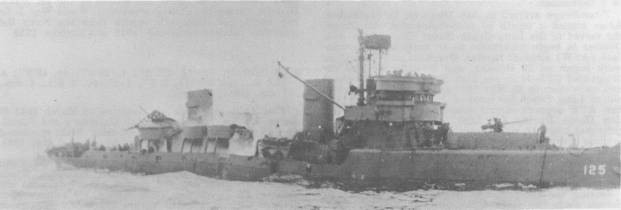
Tide (SP-953), a tug built in 1916 at Manitowoc, Wis., by the Manitowoc Shipbuilding Co., was acquired by the Navy on 14 June 1918 from the Bay State Fishing Co., of Boston, Mass., to serve as a minesweeper in the 1st Naval District. Though never commissioned by the Navy, she may have been armed and manned by naval reservists to patrol the waters of the 1st Naval District during the closing months of World War I. In any event, her name was struck from the Navy list sometime between November 1918 and October 1919.
I
(AM-125: dp. 890; 1. 221'2"; b. 32'2"; dr. 10'9"; s. 18.1 k.; cpl. 105; a. 2 3", 4 20mm., 2 dot., 4 dcp., 1 dcp. (hh.) ; cl. Auk)
Tide (AM-125) was laid down on 16 March 1942 at Savannah, Ga., by the Savannah Machinery and Foundry Company; launched on 7 September 1942; sponsored by Mrs. Ruth Hangs; and commissioned on 9 May 1943, Lt. Comdr. Alvin Robinson, USNR, in command.
Following shakedown training out of Key West and Norfolk, Tide got underway from Hampton Roads for her first transatlantic voyage. On 17 July, as she steamed in convoy for North Africa, the minesweeper collided with an infantry landing craft, LCI-267, which she had just provisioned. Damage to the sweeper included sprung plates and two minor hull punctures which were repaired at sea. Tide arrived at Casablanca on 18 July and was soon on her way again escorting a convoy bound for American ports.
During the homeward voyage on 29 July, a sonar contact prompted Tide to drop depth charges on what she thought was an enemy submarine. Although a later search revealed an oil slick, no submarine sinking was confirmed.
Following her arrival at New York on 9 August, Tide operated on the Eastern Sea Frontier until 30 September. In October and November, she made another successful Atlantic crossing, returning to New York on 25 November 1943.
During December, Tide participated in exercises off the Maine coast and conducted mine warfare training off Yorktown. Convoy duties in the waters of the Eastern Sea Frontier and the Caribbean occupied her during January 1944. On the 25th, Tide got underway again for what was to be her longest convoy escort assignment. Departing Charleston, she steamed, via Bermuda and the Azores, for the United Kingdom.
Tide completed this voyage at Milford Haven harbor, England, on 10 March and spent the remainder of the month operating out of Falmouth. In April and May, she escorted convoys in British coastal waters and engaged in exercises with minesweepers of the Royal Navy in preparation for the invasion of Europe. In the last week of May, Tide made sweeps out of Babbacombe Bay.
On 5 June, Tide got underway from Tor Bay with Minesweeper Squadron "A," a unit assigned to the "Utah" area. Later that day, German mines began to take their toll as Osprey (AM-56), a squadron member, went down. As the day wore on, Tide swept channels off the Normandy beaches for fire-support ships and continued sweeps the next day, D-day. During the night of 6 and 7 June, she joined other vessels in guarding Carentan Estuary to prevent the sally of enemy E-boats.
On the morning of 7 June, Tide swept the area inshore and between St. Marcauf and Barfleur to clear lanes for fire-support ships. At 0940, while recovering her gear, Tide drifted over the Cardonet Banks and struck a mine which exploded with such force that she was lifted out of the water. The explosion broke her back, blasted a tremendous hole in her bottom, and tore away all bulkheads below the waterline causing immediate and irreversible flooding.
Tide's commanding officer, Lt. Comdr. Allard B. Heywood, USNR, died soon after the initial explosion, and Lt. Comdr. George Crane, the ship's executive officer, directed efforts to assist the stricken vessel and to rescue survivors. Threat (AM-124) and Pheasant (AM-61) tried to aid Tide, but the ship was beyond saving. When Swift (AM-122) attempted to tow the damaged ship to the beach, the strain broke her in two. She sank only minutes after the last survivors had been taken off.
Her name was struck from the Navy list on 29 July 1944.
Tide received one battle star for World War II service.


